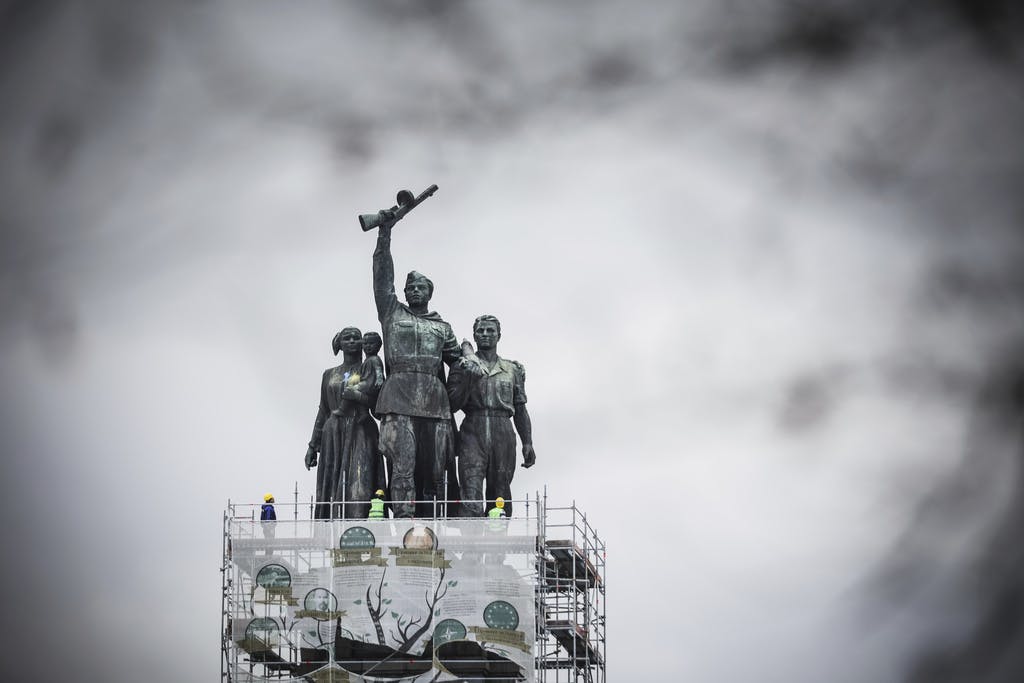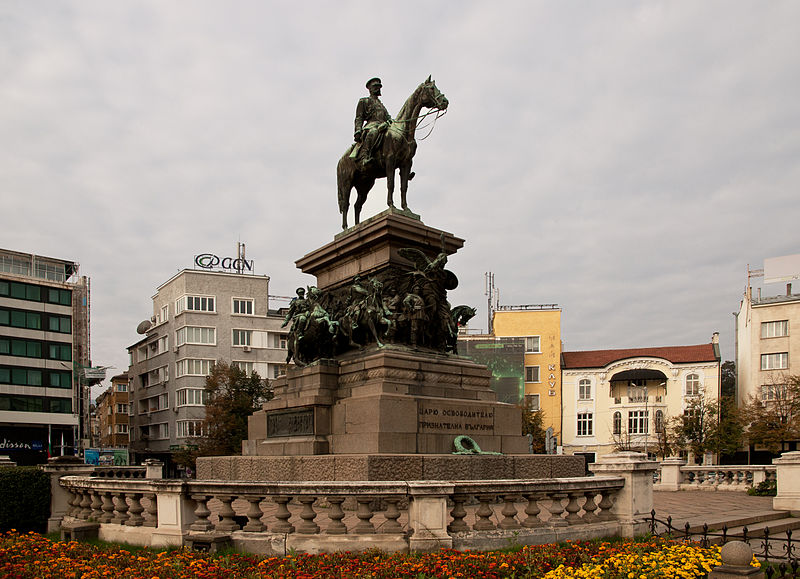While Washington Dickers, Tiny Bulgaria Races To Supply Ukraine With Bullets, Tank Shells, and Armor
Russia’s neighbors — from Norway and Finland to Romania and Bulgaria — see helping Ukraine as an existential necessity for the defense of eastern and northern Europe.

Sculpted in bronze on a base of granite, Bulgaria’s imposing “Monument to the Tsar Liberator” puts Russia’s Alexander II on a battle steed at the heart of Bulgaria’s capital, Sofia. At the base, a bas-relief memorializes the 100,000 Russian soldiers who died between 1877 and 1878 while liberating Bulgaria and much of the Balkans from Turkish rule. The tsar’s stern visage faces Bulgaria’s national parliament and one of the largest cathedrals in the orthodox world, a basilica dedicated to a Russian national hero and saint, Alexander Nevsky.
Fast-forward to today: No longer “closest Slavic brothers,” Bulgaria and Russia ended all flights shortly after Russia launched its February 24, 2022, invasion of Ukraine. Two months ago, Bulgaria banned all cars with Russian license plates. Two weeks ago, Bulgaria’s national assembly voted by a 3-to-1 margin to send 100 armored personnel carriers to Ukraine. The shipment vote overrides an earlier veto by President Radev, representative of residual pro-Moscow sentiment in the country.

To help Ukraine, Bulgaria ramped up production from its Soviet-era arms factories. This Black Sea nation of only 6.5 million people now supplies about a third of the bullets and artillery shells fired by Ukraine’s army. Ten days ago, Bulgaria and Serbia hit at Russia’s primary source of foreign exchange by inaugurating a 100-mile gas pipeline interconnector. At the expense of Russia’s Gazprom, this will allow Azerbaijan to double its gas supplies to Europe by 2027.
While American senators take a Christmas break from dickering over military aid, Russia’s neighbors — from Norway and Finland to Romania and Bulgaria — see helping Ukraine as an existential necessity for the defense of eastern and northern Europe. On Saturday, a Russian Duma member, Andrei Gurulyov, became the latest member of the Kremlin elite to publicly warn: Russia will not stop at Ukraine. Speaking on state television, he said: “We will win. There is no other option. We will confidently get there — and then go further.”
Alarms bells ring loud and clear in Bulgaria, a Pennsylvania-size country sandwiched between Turkey and Romania. Russia’s menace is not an abstraction to Bulgarians who face Russia-controlled Crimea across 300 miles of the Black Sea. Last month, Bulgaria’s defense minister, Todor Tagarev, said in a parliamentary debate: “By protecting itself, Ukraine is protecting Europe from the Kremlin. If Ukraine loses, be ready to at least double the resources Bulgaria allocates for defense.”
The immediate threat is to Black Sea shipping lanes. Until Ukrainian missiles and sea drones in the autumn forced Russia’s Black Sea fleet to retreat from the western Black Sea, Russia closed large swathes of this international body of water for live-fire exercises. Since August, Ukraine has managed to keep open an export shipping corridor from its Odessa region ports. So far, about 160 civilian cargo ship have used this shipping lane, which hugs the coasts of Ukraine, Romania, and Bulgaria. Yet Russian planes have sown sea mines in the area. Two cargo vessels hit mines in October.
On January 11, the defense ministers of Turkey, Romania, and Bulgaria — all NATO members — plan to sign in Istanbul an agreement on joint clearance of mines from the Black Sea. “Our mine-clearing vessels will carry out constant patrols to the point where Romania’s [sea] borders end,” Turkey’s defense minister, Yasar Guler, told reporters at Ankara last Saturday. Last week, Britain said it would transfer two Royal Navy mine-hunting vessels to the Ukrainian navy, as part of a new maritime defense coalition.
Although the poorest nation of the European Union’s 27-country bloc, Bulgaria is part of a wider European drive to modernize militaries in face of the Russian threat. The Stockholm International Peace Research Institute reported in its latest review of global military spending: “Military expenditure by states in Central and Western Europe totaled $345 billion in 2022. In real terms, spending by these states for the first time surpassed that in 1989, as the Cold War was ending, and was 30 percent higher than in 2013.”
A Stockholm International Peace Research Institute researcher, Diego Lopes da Silva, said: “The invasion of Ukraine had an immediate impact on military spending decisions in Central and Western Europe. As a result, we can reasonably expect military expenditure in Central and Western Europe to keep rising in the years ahead.”
Two weeks ago, Bulgaria’s parliament voted to allow Ukrainian pilots to use Bulgarian air space to train on NATO-supplied F-16s. This would be facilitated out of Bezmer Air Base, one of four U.S.-Bulgarian Joint Military Facilities set up in 2006, using former Warsaw Pact bases. One month after Russia’s invasion of Ukraine, the American secretary of defense, Lloyd Austin, visited Bezmer, the main base for Bulgaria’s air force.
With Bulgaria exporting $1 billion worth of armaments a year to Ukraine, Russia is not ignoring the turnaround by its old ally. Over the last year, there have been two suspicious explosions at Bulgarian warehouses storing ammunition for Ukraine. A Bulgarian arms dealer, Emilian Gebrev, owner of the warehouses, says he was twice poisoned in 2015 by a nerve agent similar to Novichok, the agent used by the Kremlin to kill its opponents. The poisonings took place after Mr. Gebrev’s Emco company sold bullets and tank shells to Ukraine after Russia’s annexation of Crimea in 2014.
Although a dozen mysterious fires and explosions have hit Bulgarian arms factories and warehouses over the last decade, there have been no arrests. Mr. Gebrev and others charge that Russia has successfully infiltrated prosecutors’ offices. Prosecutors say they have charged six suspects from Russia’s GRU, or military intelligence. All the suspects are in Russia, which lacks an extradition treaty to Bulgaria.
Although some sympathy remains for Russia, Bulgarian attitudes are hardening. About 60,000 Ukrainian refugees now live in Bulgaria — double the Russian population. About 20,000 ethnic Bulgarians live under Russian occupation in Ukraine. One year ago, two-thirds of Bulgarians interviewed by a pollster wanted their government to remain neutral in the war. Last summer, 64 percent favored supplying military aid to Ukraine, and 66 percent wanted the government to ban Russian state-owned media.
Yesterday, two miles from Sofia’s “Tsar Liberator” statue, men working with metal saws completed cutting up a massive, Stalin-era monument to the Soviet Army. This week-long dismantling ends a decade of debate. Lower friezes of the heroic monument had been painted in the blue and gold colors of the Ukrainian flag.
An art collective nicknamed the “Banksy of Bulgaria” painted Soviet soldiers in the bright colors of American superheroes. To mollify Soviet nostalgists, authorities promised to re-erect the monument in the Museum of Socialist Art. Yet art critics doubt that money will be spent to put Sofia’s 100-ton Humpty Dumpty back together again.

